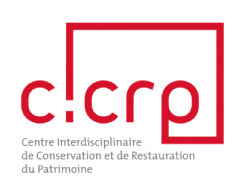Identification of inorganic constituents in the coloured preparations of easel paintings of the 17th and 18th centuries
Programme start: 2006
CICRP: Christine Benoit
Coloured layers, most often red or brown, have been used in the 17th and 18th to prepare the canvases of Western easel paintings. These preparation layers consist of iron oxides, ochres or earths, used with an oil binder, alone or in combination with other extenders.

Stratigraphy of a painting and its pictorial layers.
La chartreuse de Marseille, anonymous 18th-century work,
La Grande Chartreuse collection, Correrie Museum.
The study of the chemical composition of these preparations has several implications in the domain of conservation and restoration. Certain coloured preparations react to aqueous treatments, as a result of the presence of swelling clays in the pigment used.
Ochres are substances of essentially local provenance; determining their stratigraphic origin provides information on the location of the painting’s creation. The study of applications and their variations can contribute towards establishing schooling practices and serve as a chronological marker in the career of an artist.
Several lines of investigation have been explored: the development of identification protocols for the ochre constituents, particularly the clays and the swelling clays; the collection and analysis of ochres and natural earths of known provenance that can serve as a reliable reference for the study of ancient samples of unknown provenance; and the analysis of samples from ancient paintings bearing coloured preparations.

Coloured preparations of Provence. Michel Serre, L’apothéose de saint Roch [The Apotheosis of Saint Roch], Church of Mazargues
The collection and analysis of samples is carried out systematically on paintings restored by the CICRP to obtain statistically significant results.


